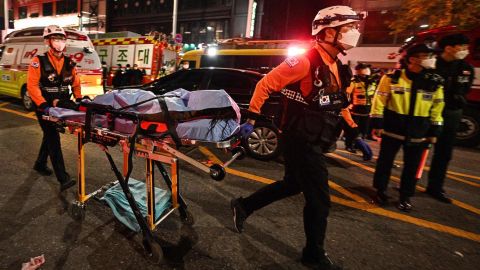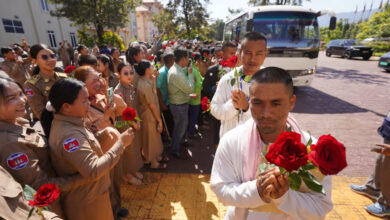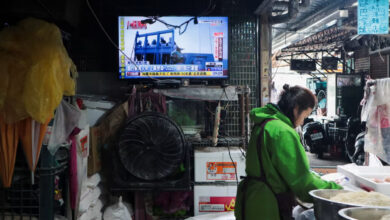
On Saturday night, tens of thousands of people flooded into the area in central Seoul to celebrate Halloween – but panic erupted as the crowds swelled, with some witnesses saying it became hard to breathe and impossible to move.
At least 151 were killed in the crush, with dozens more injured. Authorities have now launched an urgent investigation to find out how what was supposed to be a night of celebration went so horribly wrong, as families across the country mourn and search for missing loved ones.
Here’s what we know so far.
Why were the crowds so big?
Itaewon has long been a popular place to celebrate Halloween, especially as the holiday became more popular in Asia in recent years. Some even fly into Seoul from other countries in the region for the festivities.
But for the past two years, celebrations were muted by pandemic restrictions on crowd sizes and mask mandates.
Saturday night marked the first Halloween since the country lifted these restrictions – lending it particular significance for many eager participants in Seoul, as well as international visitors including foreign residents and tourists.
Hotels and ticketed events in the neighborhood had been booked solid in advance, and large crowds were expected.
What happened?
Witnesses told CNN there was very little – if any – crowd control before the mass of people turned deadly.
Videos and photos posted to social media show people crammed together, standing shoulder to shoulder in the narrow street.
Crowds are not unusual for that area, or for Seoul residents, who are used to jam-packed subways and streets in a city of almost 10 million.
One eyewitness said it took some time for people to realize something was wrong, with people’s panicked screams competing with music blaring from the surrounding clubs and bars.

After the first emergency calls came in around 10:24 p.m., authorities rushed to the scene – but the sheer volume of people made it difficult to reach those who needed help.
Video posted to social media showed people performing compressions on other partygoers lying on the ground as they waited for medical assistance.
The thousands of people in Halloween costumes contributed to the widespread sense of confusion and chaos. One witness described seeing a police officer shouting during the disaster – but some revelers mistook him for another partygoer.
The cause of the crush is still under investigation, though officials said there were no gas leaks or fires on site.
Who were the victims?
The casualties were young, mostly in their teens and early 20s, authorities said. Known for its nightlife and trendy restaurants, Itaewon is popular among backpackers and international students.
Among the 151 dead were 19 foreign nationals, with victims from Iran, Norway, China, Thailand and Uzbekistan, according to authorities.
More than 90% of the victims have been identified, South Korea’s Minister of Interior and Safety Lee Sang-min said on Sunday.
He added that about 10 people can’t be identified, as some are under the age of 17 – too young to hold a national ID card – and others are foreign nationals.
As of 2 p.m. Sunday local time, Seoul authorities had received 3,580 missing persons reports, said the city government. That number could include multiple reports for the same person, or reports filed Saturday night for people who have since been found.

What was the official response?
Lee Sang-min, Minister of the Interior and Safety, said on Sunday that “a considerable number” of police and security forces had been sent to another part of Seoul on Saturday in response to expected protests there.
Meanwhile in Itaewon, the crowd had not been unusually large, he said, so only a “normal” level of security forces had been deployed there.
As the disaster unfolded Saturday night, more than 1,700 emergency response forces were dispatched, including more than 500 firefighters, 1,100 police officials, and about 70 government workers.
President Yoon Suk Yeol called an emergency meeting and urged officials to identify the dead as soon as possible.
But even hours later, families were still waiting to find out if their loved ones survived.
In the immediate aftermath, many people were transferred to nearby facilities, while bodies were taken to multiple hospital mortuaries. Families gathered at sites near the scene, where officials were compiling the names of the missing and deceased.

Yoon promised to implement new measures to prevent similar incidents from happening again, saying the government would “conduct emergency inspections not only for Halloween events but also for local festivals and thoroughly manage them so they are conducted in an orderly and safe manner.”
The government will also provide psychological treatment and a fund for families of the deceased and injured. Authorities have declared a national mourning period until November 5, and designated the district of Yongsan-gu, where Itaewon is located, a special disaster area.
Questions being asked
As a stunned and grieving nation grapples with the tragedy, questions are also emerging about how such a disaster could have unfolded in a popular area where people are known to gather.
It’s hard to pinpoint what might have triggered the crush – but authorities “would have anticipated high numbers … before Saturday night,” said Juliette Kayyem, a disaster management expert and national security analyst for CNN.
“There is a responsibility on the part of the authorities to be monitoring crowd volume in real time, so they can sense the need to get people out,” she added.
Suah Cho, 23, was caught up in the crowd but managed to escape into a building along the alley. When asked whether she had seen any officials trying to limit the number of people entering the alley, she replied: “Before the incident, not at all.”
Another eyewitness described the situation getting “worse and worse,” saying they could hear “people asking for help for other people, because there were not enough rescuers that can just handle all that.”




